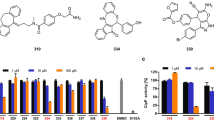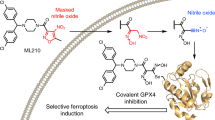Summary
PABA/NO is a diazeniumdiolate selectively activated by glutathione S-transferase P (GSTP) to release nitric oxide (NO) and is a potent inducer of protein S-glutathionylation, a redox-sensitive post-translational modification of cysteine residues. Using a procedure that incrementally increased exposure of cells to PABA/NO, an acquired drug resistant human promyelocytic leukemia HL60 cell line (HL60PABA) that exhibited 1.9-fold resistance to the drug (IC50 ∼15 μM vs ∼8 μM for wild-type) was created. HL60PABA cells had a decreased growth rate attributable to altered cellular differentiation, as measured by increased expression of CD11b; decreased expression of CD14; decreased nuclear to cytoplasmic ratios and a condensation of nuclear chromatin. This was accompanied by alterations in both plasma and mitochondrial membrane potentials. Both GSTP expression and nitric oxide release were reduced two-fold, while increased expression levels of genes involved in the unfolded protein response (UPR) were evident in HL60PABA cells. Wild type cells treated with PABA/NO had increased levels of protein S-glutathionylation and JNK activation, while JNK was constitutively active in HL60PABA cells and these cells had reduced levels of S-glutathionylation. By removing PABA/NO from the growth medium, HL60PABA cells reverted to sensitivity within 21 days suggesting that resistance was not genetically stable. Mechanistically, PABA/NO resistance is mediated through reduced levels of GSTP resulting in reduced NO release and its subsequent alterations in cellular response to nitrosative stress.








Similar content being viewed by others
Abbreviations
- PABA/NO:
-
(O2- {2,4-dinitro-5-[4-(N-methylamino)benzoyloxy]phenyl} 1-(N,N-dimethylamino)diazen-1-ium-1,2-diolate)
- GSH:
-
Glutathione reduced
- GSSG:
-
Glutathione oxidized
- ER-stress:
-
Endoplasmic reticulum stress
- GSTP:
-
Glutathione S-transferase P
- PDI:
-
Protein disulfide isomerase
- Tg:
-
Thapsigargin
- JNK:
-
c-Jun N-terminal kinase
- ROS-RNS:
-
Reactive oxygen and nitrogen species
- NO:
-
Nitric oxide
- TCEP:
-
Tris(2-carboxyethyl) phosphine
- UPR:
-
Unfolded protein response
References
Hayes JD, Pulford DJ (1995) The glutathione S-transferase supergene family: regulation of GST and the contribution of the isoenzymes to cancer chemoprotection and drug resistance. Crit Rev Biochem Mol Biol 30(6):445–600
McIlwain CC, Townsend DM, Tew KD (2006) Glutathione S-transferase polymorphisms: cancer incidence and therapy. Oncogene 25(11):1639–1648
Cowell IG et al (1988) The structure of the human glutathione S-transferase pi gene. Biochem J 255(1):79–83
Laisney V et al (1984) Human genes for glutathione S-transferases. Hum Genet 68(3):221–227
Tew KD (1994) Glutathione-associated enzymes in anticancer drug resistance. Cancer Res 54(16):4313–4320
Tew KD (2007) Redox in redux: emergent roles for glutathione S-transferase P (GSTP) in regulation of cell signaling and S-glutathionylation. Biochem Pharmacol 73(9):1257–1269
Tew KD (2005) TLK-286: a novel glutathione S-transferase-activated prodrug. Expert Opin Investig Drugs 14(8):1047–1054
Furchgott RF (1999) Endothelium-derived relaxing factor: discovery, early studies, and identification as nitric oxide. Biosci Rep 19(4):235–251
Townsend DM et al (2006) A glutathione S-transferase pi-activated prodrug causes kinase activation concurrent with S-glutathionylation of proteins. Mol Pharmacol 69(2):501–508
Wink DA et al (1998) The multifaceted roles of nitric oxide in cancer. Carcinogenesis 19(5):711–721
Saavedra JE et al (2001) The secondary amine/nitric oxide complex ion R(2)N[N(O)NO](-) as nucleophile and leaving group in S9N)Ar reactions. J Org Chem 66(9):3090–3098
Saavedra JE et al (2006) PABA/NO as an anticancer lead: analogue synthesis, structure revision, solution chemistry, reactivity toward glutathione, and in vitro activity. J Med Chem 49(3):1157–1164
Saavedra JE et al (2000) Esterase-sensitive nitric oxide donors of the diazeniumdiolate family: in vitro antileukemic activity. J Med Chem 43(2):261–269
Udupi V et al (2006) JS-K, a nitric oxide prodrug, induces cytochrome c release and caspase activation in HL-60 myeloid leukemia cells. Leuk Res 30(10):1279–1283
Findlay VJ et al (2004) Tumor cell responses to a novel glutathione S-transferase-activated nitric oxide-releasing prodrug. Mol Pharmacol 65(5):1070–1079
Livak KJ, Schmittgen TD (2001) Analysis of relative gene expression data using real-time quantitative PCR and the 2(-Delta Delta C(T)) method. Methods 25(4):402–408
Rozen S, Skaletsky H (2000) Primer3 on the WWW for general users and for biologist programmers. Methods Mol Biol 132:365–386
Townsend DM, Manevich Y, He L, Hutchens S, Tew KD (2009) Nitrosative-stress induced S-glutathionylation of PDI leads to activation of the unfolded protein response. Cancer Res 69:7626–7634
Ishimoto TM, Ali-Osman F (2002) Allelic variants of the human glutathione S-transferase P1 gene confer differential cytoprotection against anticancer agents in Escherichia coli. Pharmacogenetics 12(7):543–553
Townsend DM (2007) S-glutathionylation: indicator of cell stress and regulator of the unfolded protein response. Mol Interv 7(6):313–324
Townsend DM et al (2009) Novel role for glutathione S-transferase pi. Regulator of protein S-Glutathionylation following oxidative and nitrosative stress. J Biol Chem 284(1):436–445
Mosmann T (1983) Rapid colorimetric assay for cellular growth and survival: application to proliferation and cytotoxicity assays. J Immunol Methods 65(1–2):55–63
Collins SJ et al (1978) Terminal differentiation of human promyelocytic leukemia cells induced by dimethyl sulfoxide and other polar compounds. Proc Natl Acad Sci USA 75(5):2458–2462
Rosario LA et al (2000) Cellular response to a glutathione S-transferase P1-1 activated prodrug. Mol Pharmacol 58(1):167–174
Xu C et al (2004) Specific structural requirements for the inhibitory effect of thapsigargin on the Ca2+ ATPase SERCA. J Biol Chem 279(17):17973–17979
Paula S, Ball WJ Jr (2004) Molecular determinants of thapsigargin binding by SERCA Ca2+-ATPase: a computational docking study. Proteins 56(3):595–606
Adachi T et al (2004) S-Glutathiolation by peroxynitrite activates SERCA during arterial relaxation by nitric oxide. Nat Med 10(11):1200–1207
Shami PJ et al (2006) Antitumor activity of JS-K [O2-(2, 4-dinitrophenyl) 1-[(4-ethoxycarbonyl)piperazin-1-yl]diazen-1-ium-1, 2-diolate] and related O2-aryl diazeniumdiolates in vitro and in vivo. J Med Chem 49(14):4356–4366
Acknowledgements
Supported by NCI National Cancer Institute grants CA08660 and CA117259. We thank Cameron McIlwain for her initial role in creating the drug resistant cell lines and the Drug Metabolism and Pharmacokinetics and Flow Cytometry Core Facilities of the Hollings Cancer Center.
Author information
Authors and Affiliations
Corresponding author
Rights and permissions
About this article
Cite this article
Hutchens, S., Manevich, Y., He, L. et al. Cellular resistance to a nitric oxide releasing glutathione S-transferase P-activated prodrug, PABA/NO. Invest New Drugs 29, 719–729 (2011). https://doi.org/10.1007/s10637-010-9407-5
Received:
Accepted:
Published:
Issue Date:
DOI: https://doi.org/10.1007/s10637-010-9407-5




